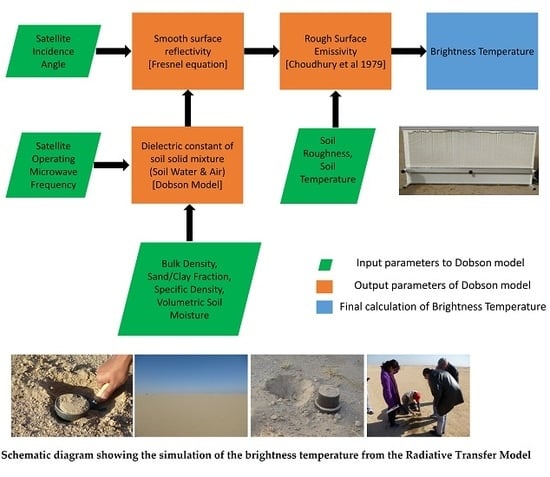Forward Simulation of Multi-Frequency Microwave Brightness Temperature over Desert Soils in Kuwait and Comparison with Satellite Observations
Abstract
1. Introduction
2. Methodology
2.1. Study Area
2.2. Field Campaigns and Satellites’ Data Sets
2.2.1. Soil Moisture Sampling
2.2.2. Soil Texture and Roughness
2.2.3. Land Surface Temperature
2.3. Forward Brightness Temperature Model
3. Results and Discussion
3.1. Analysis of In Situ Observations
3.2. Verification of the Forward Model in the Desert Environment
3.3. Discussion
4. Conclusions
Author Contributions
Funding
Acknowledgments
Conflicts of Interest
References
- Yang, Q.; Fu, B.; Wang, J.; Chen, L. Spatial variability of Soil moisture content and its relation to environmental indices in a semi-arid gully catchment of the loess Plateau, China. J. Arid Environ. 2001, 49, 723–750. [Google Scholar]
- Famiglietti, J.S.; Ryu, D.; Berg, A.A.; Rodell, M.; Jackson, T.J. Field observations of soil moisture variability across scales. Water Resour. Res. 2008, 44, 1–16. [Google Scholar] [CrossRef]
- Marouane, T.; Lakhankar, T.; Zhan, X.; Cosh, M.; Krakauer, N.; Kelly, V.; Kumissi, L. A ground based L band radiometer for the monitoring of soil moisture in the region of Millbrook, New York, USA. Vadose Zone J. 2014, 13, 1–10. [Google Scholar]
- Coopersmith, E.J.; Cosh, M.H.; Bell, J.E.; Kelly, V.; Hall, M.; Palecki, M.A.; Temimi, M. Deploying temporary networks for upscaling of sparse network stations. Int. J. Appl. Earth Observ. Geoinf. 2016, 52, 433–444. [Google Scholar] [CrossRef]
- Cosh, M.H.; Jackson, T.J.; Moran, S.; Bindlish, R. Temporal persistence and stability of surface soil moisture in a semi- arid watershed. Remote Sens. Environ. 2008, 112, 304–313. [Google Scholar] [CrossRef]
- Grayson, R.; Western, F.H.S.C.; Blöschl, G. Preferred states in spatial soil moisture patterns: Local and nonlocal controls. Water Resour. Res. 1997, 33, 2897–2908. [Google Scholar] [CrossRef]
- Schneider, K.; Huisman, L.; Breuer, Y.Z.; Frede, H.-G. Temporal stability of soil moisture in various semi-arid steppe ecosystems and its application in remote sensing. J. Hydrol. 2008, 359, 16–29. [Google Scholar] [CrossRef]
- Ryu, D.; Famiglietti, J.S. Characterization of footprint-scale surface soil moisture variability using Gaussian and beta distribution functions during the Southern Great Plains 1997 (SGP97) hydrology experiment. Water Resour. Res. 2005, 41, 1–13. [Google Scholar] [CrossRef]
- Dara Entekhabi, E.; Njoku, P.; Kellogg, W.; Crow, W.; Edelstein, J.; Entin, S.; Goodman, T.; Jackson, J.J.; Piepmeier, R.; et al. The soil moisture active passive (SMAP) mission. Proc. IEEE 2010, 98, 704–716. [Google Scholar] [CrossRef]
- Colliander, A.; Jackson, T.J.; Bindlish, R.; Chan, S.; Das, N.; Kim, S.B.; Cosh, M.H.; Dunbar, R.S.; Dang, L.; Pashaian, L.; et al. Validation of SMAP surface soil moisture products with core validation sites. Remote Sens. Environ. 2017, 191, 215–231. [Google Scholar] [CrossRef]
- Wigneron, J.P.; Jackson, T.J.; O’Neill, P.; De Lannoy, G.; De Rosnay, P.; Walker, J.P.; Ferrazzoli, P.; Mironov, V.; Bircher, S.; Grant, J.P.; et al. Modelling the passive microwave signature from land surfaces: A review of recent results and application to the L-band SMOS & SMAP soil moisture retrieval algorithms. Remote Sens. Environ. 2017, 192, 238–262. [Google Scholar]
- Kerr, Y.H.; Waldteufel, P.; Wigneron, J.P.; Martinuzzi, J.A.M.J.; Font, J.; Berger, M. Soil moisture retrieval from space: The soil moisture and ocean salinity (SMOS) mission. IEEE Trans. Geosci. Remote Sens. 2001, 39, 1729–1735. [Google Scholar] [CrossRef]
- Jackson, T.J.; Bindlish, R.; Cosh, M.H.; Zhao, T.; Starks, P.J.; Bosch, D.D.; Seyfried, M.; Moran, M.S.; Goodrich, D.C.; Kerr, Y.H.; et al. Validation of soil moisture and ocean salinity (SMOS) soil moisture over watershed networks in the US. Trans. Geosci. Remote Sens. 2012, 50, 1530–1543. [Google Scholar] [CrossRef]
- Jackson, T.J. Soil moisture estimation using special satellite microwave/imager satellite data over a grassland region. Water Resour. Res. 1997, 33, 1475–1484. [Google Scholar] [CrossRef]
- Paloscia, S.; Macelloni, G.; Santi, E.; Koike, T. A multifrequency algorithm for the retrieval of soil moisture on a large scale using microwave data from SMMR and SSM/I satellites. IEEE Trans. Geosci. Remote Sens. 2001, 39, 1655–1661. [Google Scholar] [CrossRef]
- Wen, J.; Jackson, T.J.; Bindlish, R.; Hsu, A.Y.; Su, Z.B. Retrieval of soil moisture and vegetation water content using SSM/I data over a corn and soybean region. J. Hydrometeorol. 2005, 6, 854–863. [Google Scholar] [CrossRef]
- Parinussa, R.M.; Holmes, T.R.; Wanders, N.; Dorigo, W.A.; de Jeu, R.A. A preliminary study toward consistent soil moisture from AMSR2. J. Hydrometeorol. 2015, 16, 932–947. [Google Scholar] [CrossRef]
- Bindlish, R.; Cosh, M.H.; Jackson, T.J.; Koike, T.; Fujii, H.; Chan, S.K.; Asanuma, J.; Berg, A.; Bosch, D.D.; Caldwell, T.; et al. GCOM-W AMSR2 soil moisture product validation using core validation sites. IEEE J. Sel. Top. Appl. Earth Observ. Remote Sens. 2018, 11, 209–219. [Google Scholar] [CrossRef]
- Nuñez-Olivieri, J.; Muñoz-Barreto, J.; Tirado-Corbalá, R.; Lakhankar, T.; Fisher, A. Comparison and downscale of AMSR2 soil moisture products with in situ measurements from the SCAN–NRCS network over Puerto Rico. Hydrology 2017, 4, 46. [Google Scholar]
- Al Jassar, H.K.; Rao, K.S.; Sabbah, I. A model for the retrieval and monitoring of soil moisture over desert area of Kuwait. Int. J. Remote Sens. 2007, 27, 329–348. [Google Scholar] [CrossRef]
- Al Jassar, H.K.; Rao, K.S. Monitoring of soil moisture over Kuwait desert using remote sensing techniques. Int. J. Remote Sens. 2010, 31, 4373–4385. [Google Scholar] [CrossRef]
- Al Jassar, H.K.; Rao, K.S. Assessment of soil moisture through field measurements and AMSR-E Remote sensing data analysis over Kuwait Desert. Kuwait J. Sci. 2015, 42, 250–260. [Google Scholar]
- Wehbe, Y.; Temimi, M.; Ghebreyesus, D.T.; Milewski, A.; Norouzi, H.; Ibrahim, E. Consistency of precipitation products over the Arabian Peninsula and interactions with soil moisture and water storage. Hydrol. Sci. J. 2018, 63, 408–425. [Google Scholar] [CrossRef]
- Halwagy, R.; Halwagy, M. Ecological studies on the desert of Kuwait II the vegetation. J. Univ. Kuwait (Sci.) 1979, 1, 87–95. [Google Scholar]
- Kokkalis, P.; Al Jassar, H.K.; Solomos, S.; Raptis, P.-I.; Al Hendi, H.; Amiridis, V.; Papayannis, A.; Al Sarraf, H.; Al Dimashki, M. Long-term ground-based measurements of aerosol optical depth over Kuwait City. Remote Sens. 2018, 10, 1807. [Google Scholar] [CrossRef]
- Kuwait Institute for Scientific Research. Soil Survey for the State of Kuwait–Volume III: Reconnaissance Soil Map of Kuwait; Kuwait Institute for Scientific Research, AACM International: Adelaide, Australia, 1999. [Google Scholar]
- Dobson, M.C.; Ulaby, F.T.; Hallikainen, M.T.; El-Rayes, M.A. Microwave dielectric behavior of wet soil—Part II: Dielectric mixing models. IEEE Trans. Geosci. Remote Sens. 1985, 23(1), 35–46. [Google Scholar] [CrossRef]
- Wang, J.R.; Choudhury, B.J. remote sensing of soil moisture content over bare field at 1.4GHz frequency. J. Geophys. Res. 1981, 86, 5277–5282. [Google Scholar] [CrossRef]
- Lane, J.A.; Saxton, J.A. Dielectric dispersion in pure polar liquids at very high radar frequencies, III, The effect of electrolytes in solution. Proc. R. Soc. Lond. 1952, 214, 531–545. [Google Scholar]
- Stogryn, A. Equations for calculating the dielectric constant of saline water. IEEE Trans. Microw. Theor. Tech. 1971, 19, 733–736. [Google Scholar] [CrossRef]
- Choudhury, B.J.; Schmugge, T.J.; Chang, A.; Newton, R.W. Effect of surface roughness on the microwave emission from soils. J. Geophys. Res. Oceans 1979, 84, 5699–5706. [Google Scholar] [CrossRef]
- Lopez, O.; Stenchikov, G.; Missimer, T.M. Water management during climate change using aquifer storage and recovery of stormwater in a dunefield in western Saudi Arabia. Environ. Res. Lett. 2014, 9, 075008. [Google Scholar] [CrossRef]
- CESBIO Soil Moisture Ocean Salinity Satellite SMOS blog. Available online: http://www.cesbio.ups-tlse.fr/SMOS_blog/?page_id=4087 (accessed on 19 July 2018).
- Njoku, E.G.; Jackson, T.J.; Lakshmi, V.; Chan, T.K.; Nghiem, S.V. Soil moisture retrieval from AMSR-E. IEEE Trans. Geosci. Remote Sens. 2003, 41, 215–229. [Google Scholar] [CrossRef]
- Montpetit, B.; Royer, A.; Wigneron, J.P.; Chanzy, A.; Mialon, A. Evaluation of multi-frequency bare soil microwave reflectivity models. Remote Sens. Environ. 2015, 162, 186–195. [Google Scholar] [CrossRef]
- Srivastava, P.K.; O’Neill, P.; Cosh, M.; Kurum, M.; Lang, R.; Joseph, A. Evaluation of dielectric mixing models for passive microwave soil moisture retrieval using data from ComRAD ground-based SMAP simulator. IEEE J. Sel. Top. Appl. Earth Observ. Remote Sens. 2014, 8, 4345–4354. [Google Scholar] [CrossRef]
- Mironov, V.L.; Kosolapova, L.G.; Fomin, S.V. Physically and mineralogically based spectroscopic dielectric model for moist soils. IEEE Trans. Geosci. Remote Sens. 2009, 47, 2059–2070. [Google Scholar] [CrossRef]
- Wang, J.R.; Schmugge, T.J. An empirical model for the complex dielectric permittivity of soils as a function of water content. IEEE Trans. Geosci. Remote Sens. 1980, GE-18, 288–295. [Google Scholar] [CrossRef]
- Hallikainen, M.T.; Ulaby, F.T.; Dobson, M.C.; El-Rayes, M.A.; Wu, L.K. Microwave dielectric behavior of wet soilpart 1: Empirical models and experimental observations. IEEE Trans. Geosci. Remote Sens. 1985, GE-23, 25–34. [Google Scholar] [CrossRef]
- Zheng, D.; van der Velde, R.; Wen, J.; Wang, X.; Ferrazzoli, P.; Schwank, M.; Colliander, A.; Bindlish, R.; Su, Z. Assessment of the SMAP soil emission model and soil moisture retrieval algorithms for a Tibetan Desert ecosystem. IEEE Trans. Geosci. Remote Sens. 2018, 56, 3786–3799. [Google Scholar] [CrossRef]
- Mironov, V.; Kerr, Y.; Wigneron, J.P.; Kosolapova, L.; Demontoux, F. Temperature- and texture-dependent dielectric model for moist soils at1.4 GHz. IEEE Geosci. Remote Sens. Lett. 2013, 10, 419–423. [Google Scholar] [CrossRef]
- Wigneron, J.P.; Laguerre, L.; Kerr, Y.H. A simple parameterization of the L-band microwave emission from rough agricultural soils. IEEE Trans. Geosci. Remote Sens. 2001, 39, 1697–1707. [Google Scholar] [CrossRef]
- Holmes, T.R.H.; De Rosnay, P.; De Jeu, R.; Wigneron, R.P.; Kerr, Y.; Calvet, J.C.; Escorihuela, M.J.; Saleh, K.; Lemaître, F. A new parameterization of the effective temperature for L band radiometry. Geophys. Res. Lett. 2006, 33, 1–4. [Google Scholar] [CrossRef]
- Mo, T.; Schmugge, T.J. A parameterization of the effect of surface roughness on microwave emission. IEEE Trans. Geosci. Remote Sens. 1987, GE-25, 481–486. [Google Scholar] [CrossRef]
- Wigneron, J.P.; Chanzy, A.; Kerr, Y.H.; Lawrence, H.; Shi, J.; Escorihuela, M.J.; Mironov, V.; Mialon, A.; Demontoux, F.; De Rosnay, P.; et al. Evaluating an improved parameterization of the soil emission in L-MEB. IEEE Trans. Geosci. Remote Sens. 2010, 49, 1177–1189. [Google Scholar] [CrossRef]
- Su, Z.; Troch, P.A.; De Troch, F.P. Remote sensing of bare surface soil moisture using EMAC/ESAR data. Int. J. Remote Sens. 1997, 18, 2105–2124. [Google Scholar] [CrossRef]
- Lievens, H.; Verhoest, N.E.; Keyser, E.D.; Vernieuwe, H.; Matgen, P.; Álvarez-Mozos, J.; Baets, B.D. Effective roughness modelling as a tool for soil moisture retrieval from C-and L-band SAR. Hydrol. Earth Syst. Sci. 2011, 15, 151–162. [Google Scholar] [CrossRef]
- Wang, J.R.; O’Neill, P.E.; Jackson, T.J.; Engman, E.T. Multifrequency measurements of the effects of soil moisture, soil texture, and surface roughness. IEEE Trans. Geosci. Remote Sens. 1983, GE-21, 44–51. [Google Scholar] [CrossRef]
- Bircher, S.; Balling, J.E.; Skou, N.; Kerr, Y.H. Validation of SMOS brightness temperatures during the HOBE airborne campaign, Western Denmark. IEEE Trans. Geosci. Remote Sens. 2012, 50, 1468–1482. [Google Scholar] [CrossRef]
- Escorihuela, M.J.; Kerr, Y.H.; de Rosnay, P.; Wigneron, J.P.; Calvet, J.C.; Lemaitre, F. A simple model of the bare soil microwave emission at L-band. IEEE Trans. Geosci. Remote Sens. 2007, 45, 1978–1987. [Google Scholar] [CrossRef]
- Park, C.H.; Behrendt, A.; LeDrew, E.; Wulfmeyer, V. New approach for calculating the effective dielectric constant of the moist soil for microwaves. Remote Sens. 2017, 9, 732. [Google Scholar] [CrossRef]
- Boyarskii, D.A.; Tikhonov, V.V.; Komarova, N.Y. Model of dielectric constant of bound water in soil for applications of microwave remote sensing. Prog. Electromagn. Res. 2002, 35, 251–269. [Google Scholar] [CrossRef]
- Bircher, S.; Andreasen, M.; Vuollet, J.; Vehviläinen, J.; Rautiainen, K.; Jonard, F.; Weihermüller, L.; Zakharova, E.; Wigneron, J.P.; Kerr, Y.H. Soil moisture sensor calibration for organic soil surface layers. Geosci. Instrum. Methods Data Syst. 2016, 5, 109–125. [Google Scholar] [CrossRef]
- Mironov, V.L.; Kosolapova, L.G.; Savin, I.V.; Muzalevskiy, K.V. Temperature dependent dielectric model at 1.4 GHz for a tundra organic-rich soil thawed and frozen. In Proceedings of the IEEE International Geoscience and Remote Sensing Symposium (IGARSS), Milan, Italy, 26–31 July 2015. [Google Scholar]
- Raju, S.; Chanzy, A.; Wigneron, J.P.; Calvet, J.C.; Kerr, Y.; Laguerre, L. Soil moisture and temperature profile effects on microwave emission at low frequencies. Remote Sens. Environ. 1995, 54, 85–97. [Google Scholar] [CrossRef]
- Wang, J. R Microwave emission from smooth bare fields and soil moisture sampling depth. IEEE Trans. Geosci. Remote Sens. 1987, 5, 616–622. [Google Scholar] [CrossRef]
- Escorihuela, M.J.; Chanzy, A.; Wigneron, J.P.; Kerr, Y.H. Effective soil moisture sampling depth of L-band radiometry: A case study. Remote Sens. Environ. 2010, 114, 995–1001. [Google Scholar] [CrossRef]
- Zheng, D.; Li, X.; Wang, X.; Wang, Z.; Wen, J.; van der Velde, R.; Schwank, M.; Su, Z. Sampling depth of L-band radiometer measurements of soil moisture and freeze-thaw dynamics on the Tibetan Plateau. Remote Sens. Environ. 2019, 226, 16–25. [Google Scholar] [CrossRef]
- Owe, M.; Van de Griend, A.A. Comparison of soil moisture penetration depths for several bare soils at two microwave frequencies and implications for remote sensing. Water Resour. Res. 1998, 34, 2319–2327. [Google Scholar] [CrossRef]
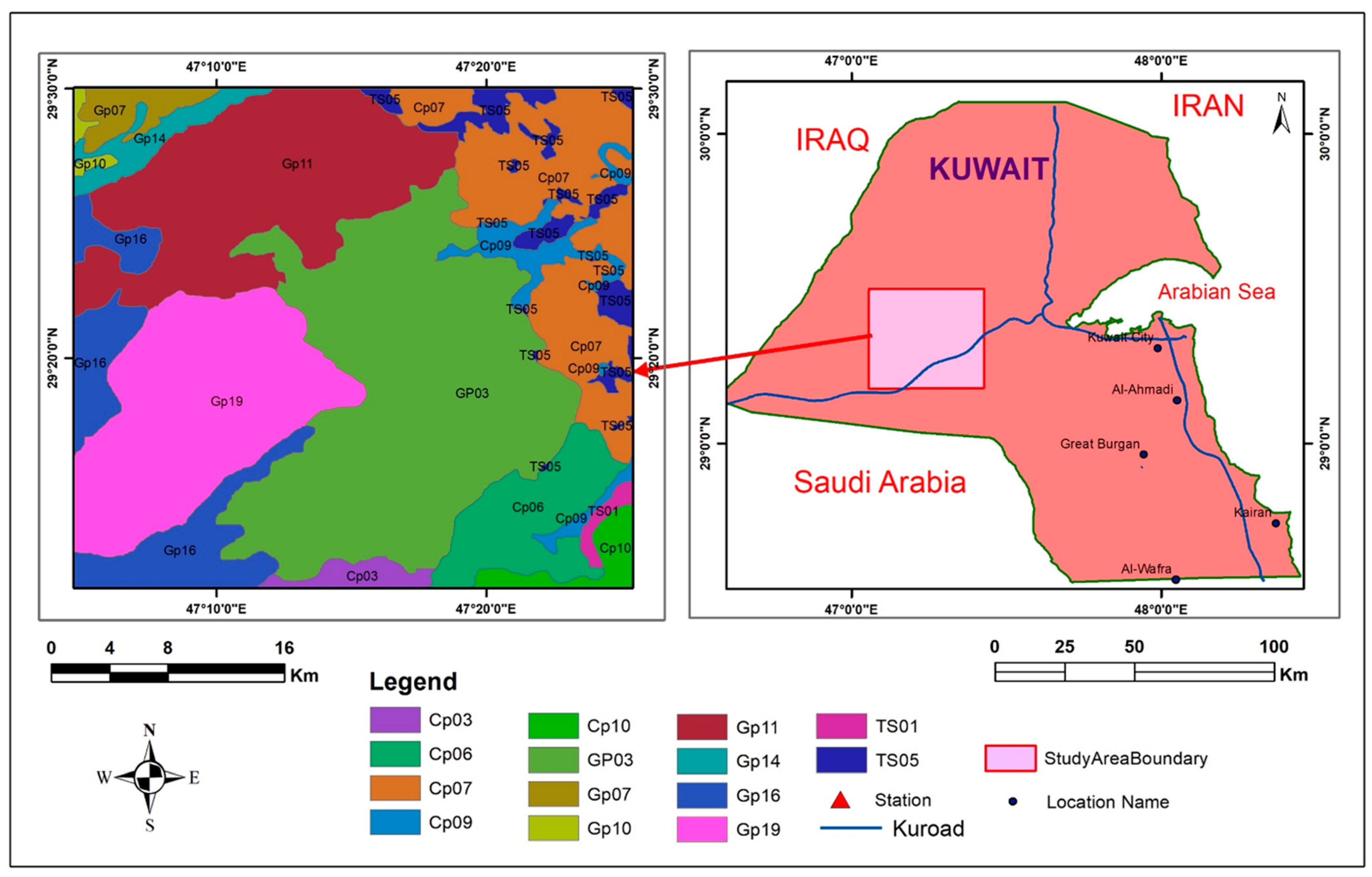
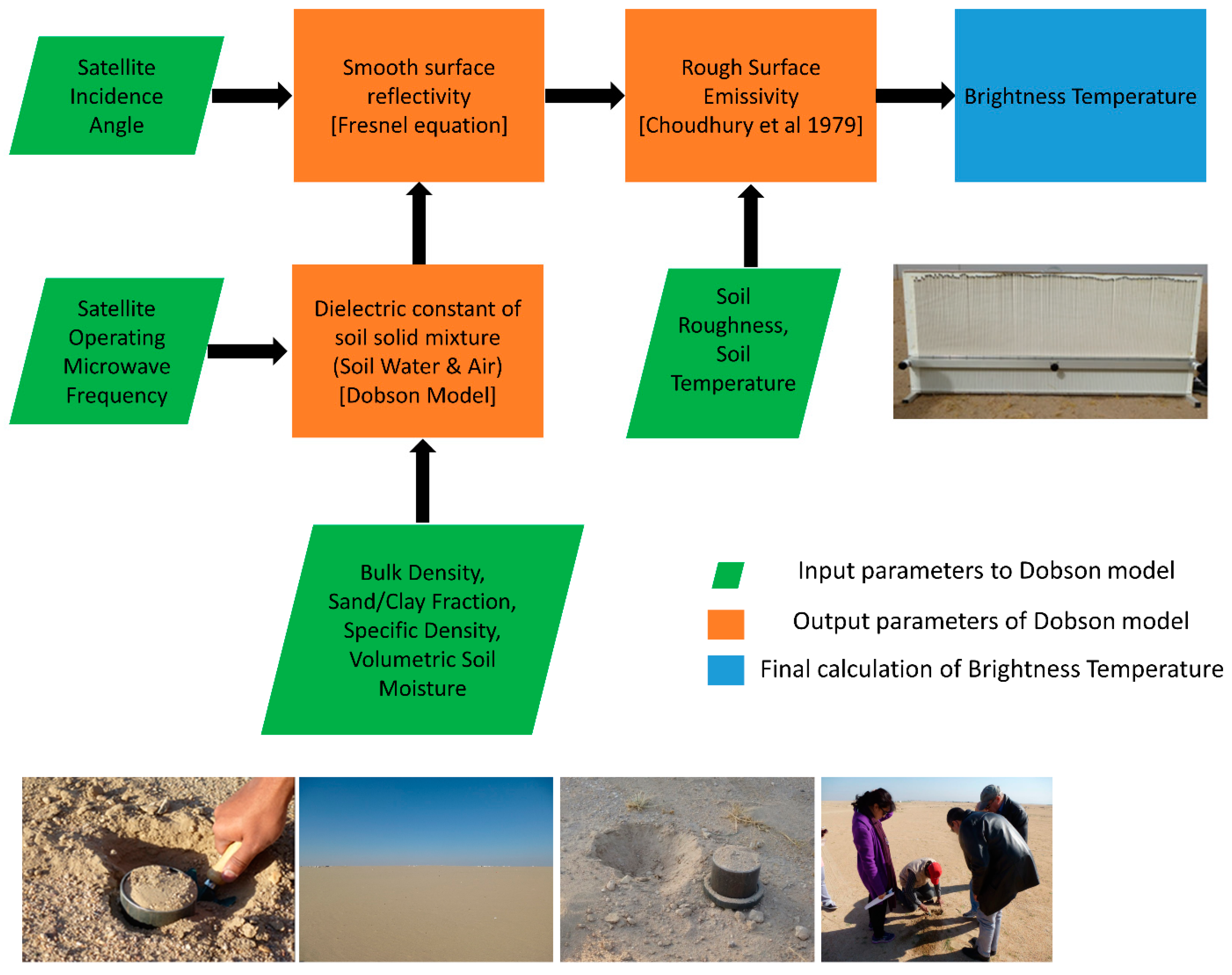
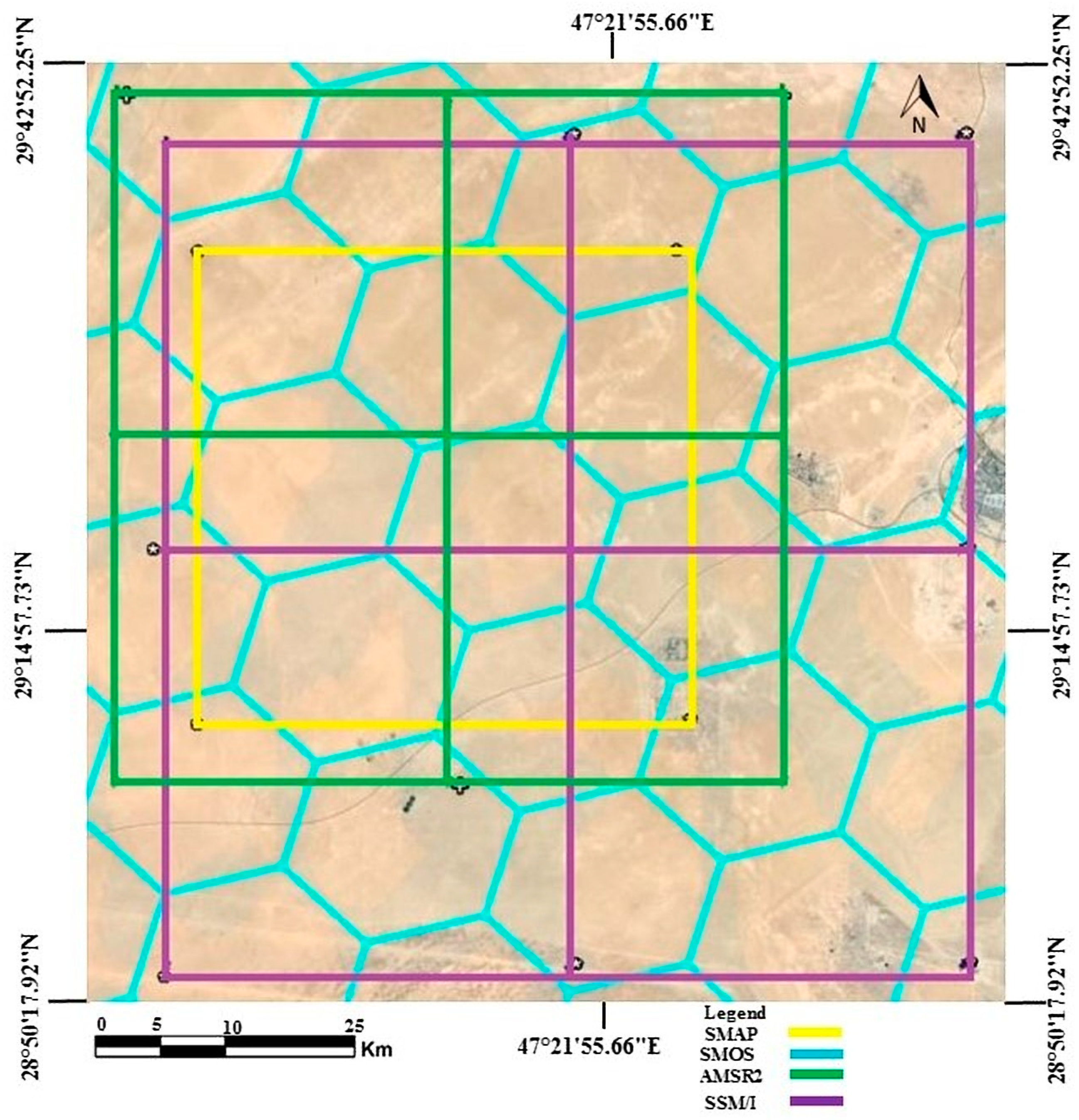
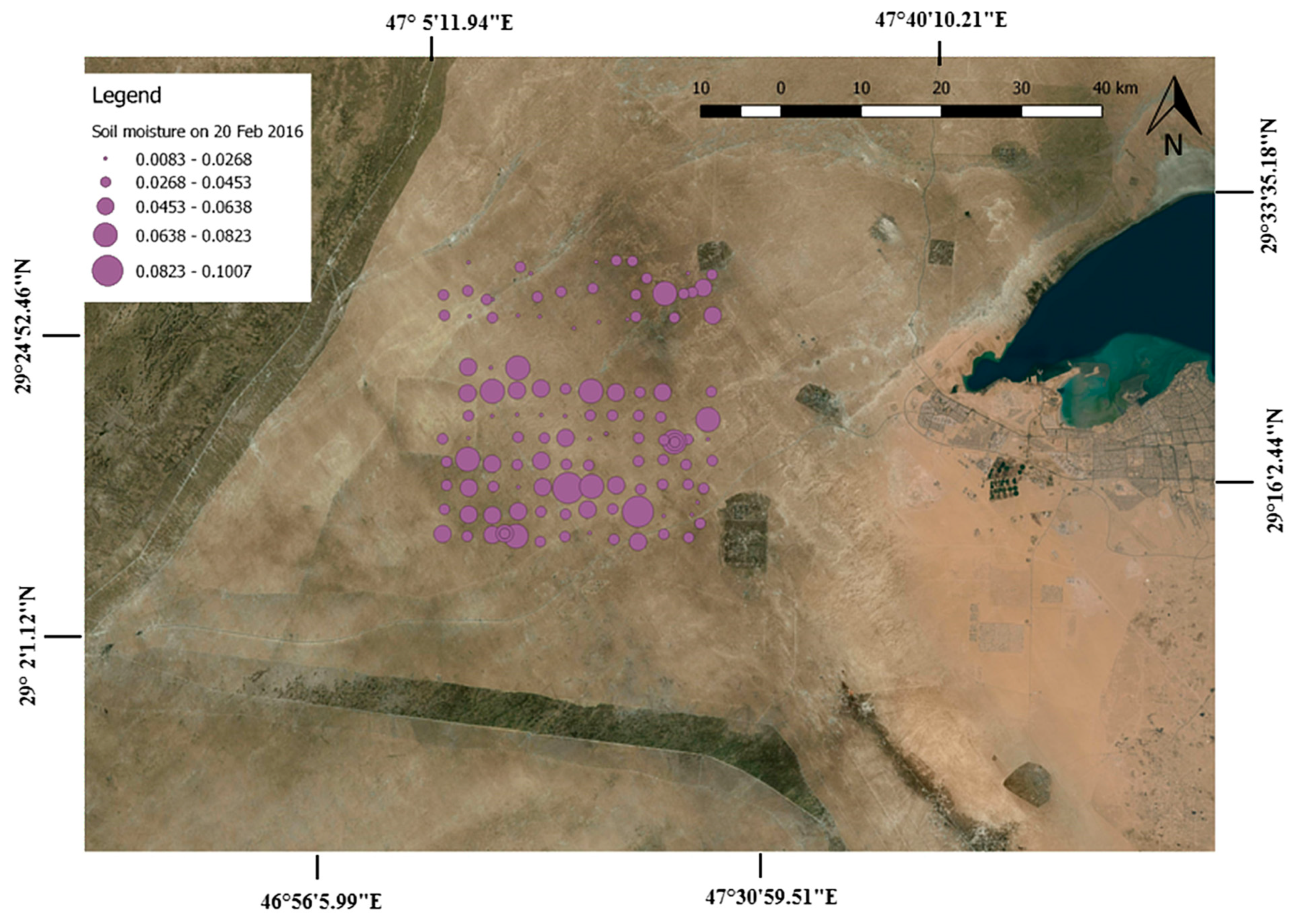

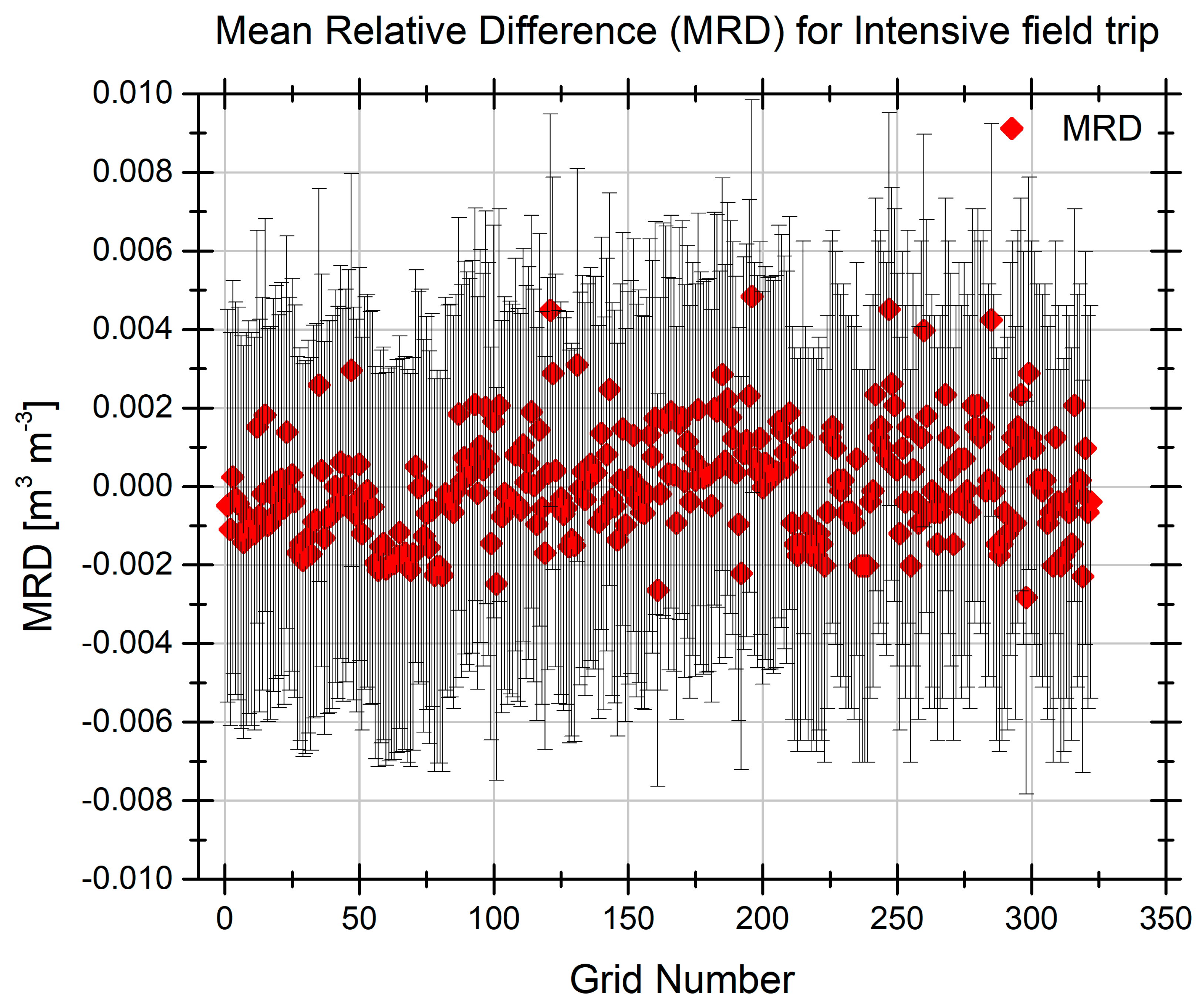
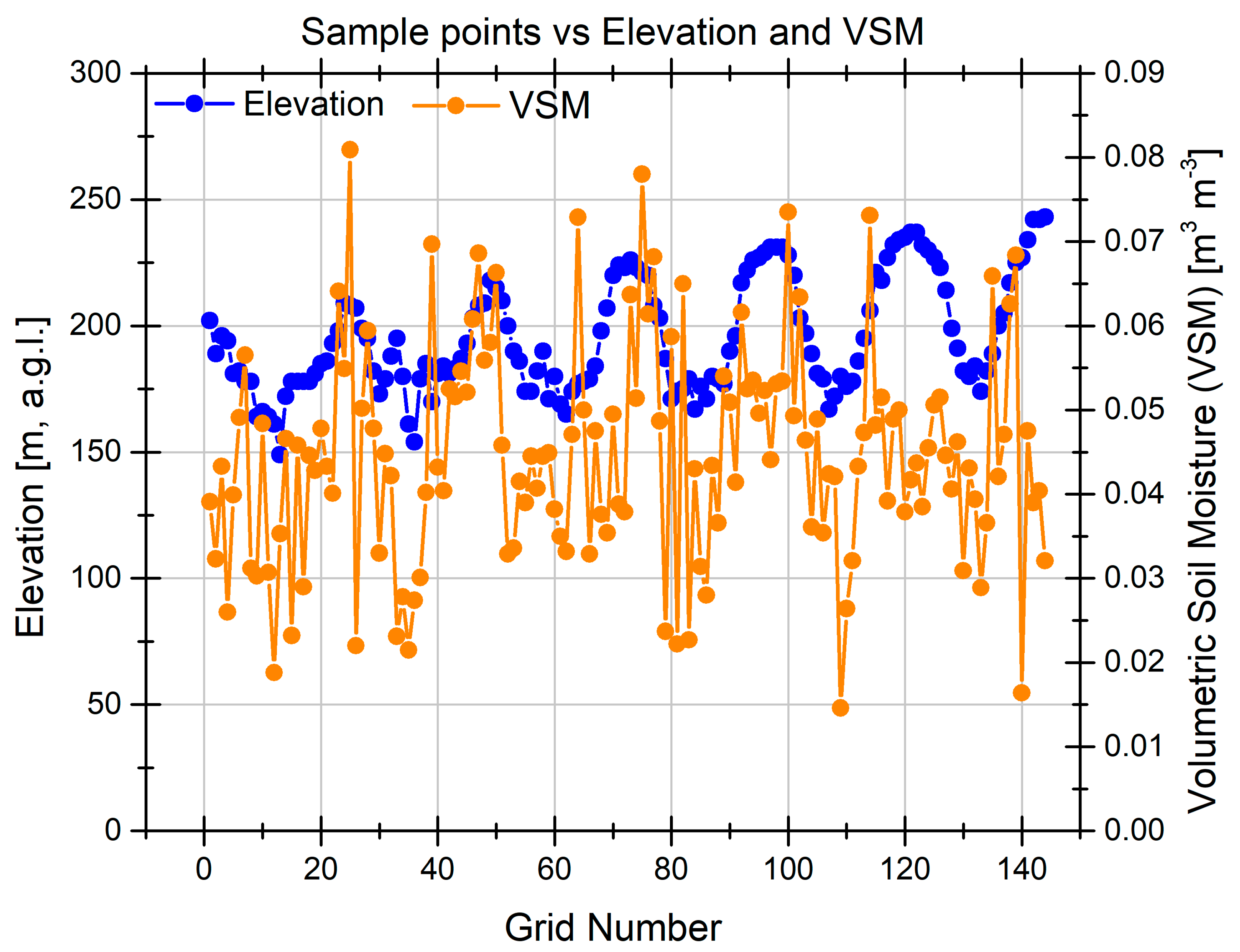
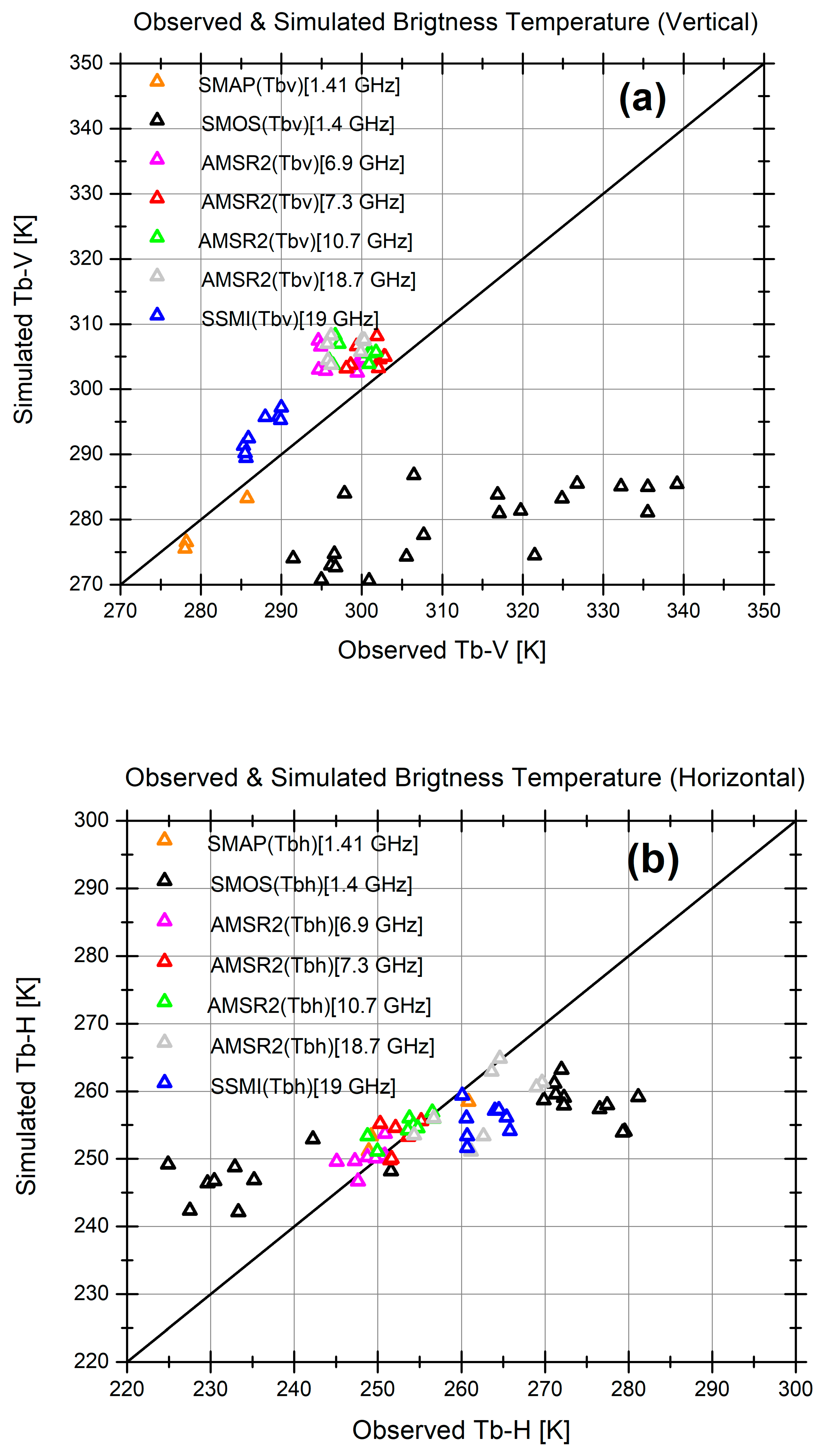

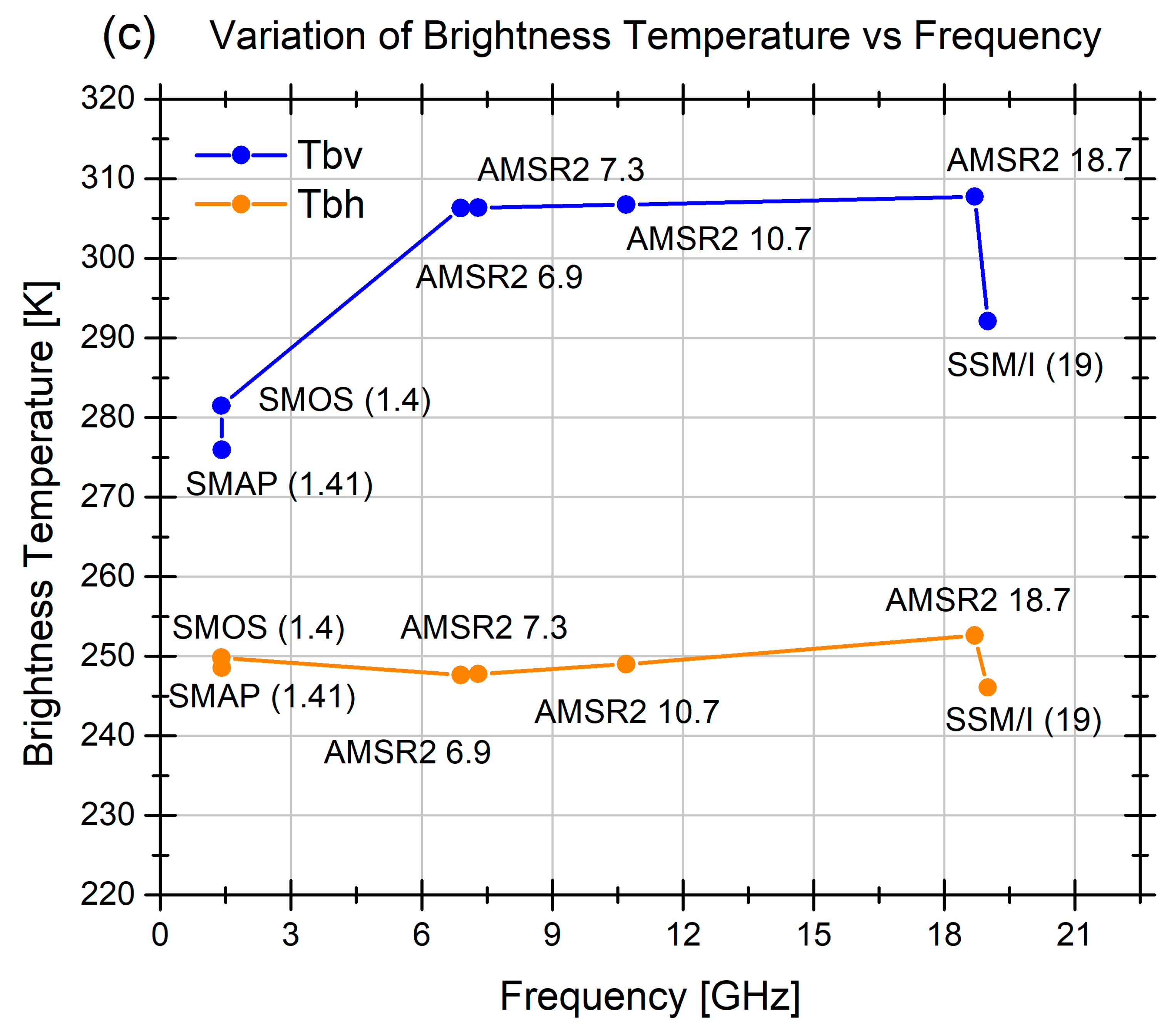
| Legend | Soil Type | Area (km2) |
|---|---|---|
| Cp03 | Calcic Petrocalcids-Petrocalcic Petrogypsids complex, nearly level | 29.5 |
| Cp06 | Calcic Petrocalcids - Typic Petrogypsids complex, nearly level | 68.05 |
| Cp07 | Calcic Petrocalcids - Typic Torripsamments complex, plain, nearly level | 146.62 |
| Cp09 | Typic Petrocalcids - shallow, gently sloping | 29.33 |
| Cp10 | Typic Petrocalcids - Calcic Petrocalcids complex, nearly level | 35.15 |
| Gp03 | Petrocalcic Petrogypsids - shallow, nearly level | 331.93 |
| Gp07 | Petrocalcic Petrogypsids - Calcic Petrocalcids complex, nearly level | 18.4 |
| Gp10 | Petrocalcic Petrogypsids - Typic Petrogypsids - Typic Torripsamments complex, nearly level | 19.1 |
| Gp11 | Petrocalcic Petrogypsids - Typic Torripsamments complex, nearly level | 204.86 |
| nGp14 | Typic Petrogypsids - strongly sloping | 26.38 |
| Gp16 | Typic Petrogypsids - Calcic Petrogypsids complex, nearly level | 149.76 |
| Gp19 | Typic Petrogypsids - Typic Haplocalcids complex, nearly level | 193.92 |
| Ts01 | Typic Torripsamments - smooth surface, gently sloping | 6.12 |
| Ts05 | Typic Torripsamments - Calcic Petrocalcids complex, moderately steep | 36.83 |
| Satellite (Day) Gridding Over Pass time | Frequency Incidence Angle (°) | Bulk Density (g cm−3) | Sand Fraction | Clay Fraction | LST_MSG (K) | VSM (m3 m−3) | Roughness Height (cm) |
|---|---|---|---|---|---|---|---|
| SMAP (20 Feb 16) 36 × 36 (km) 6:00 a.m. (Descending) | 1.41 GHz 40 | 1.750 | 0.870 | 0.030 | 292.155 | 0.040 | 0.750 |
| SMAP (18 Mar 16) 36 × 36 (km) 6:00 a.m. (Descending) | 1.41 GHz 40 | 1.780 | 0.870 | 0.030 | 299.270 | 0.046 | 0.750 |
| SMAP (18 Mar 16) 36 × 36 (km) 6:00 p.m. (Ascending) | 1.41 GHz 40 | 1.780 | 0.870 | 0.030 | 300.420 | 0.044 | 0.750 |
| SMOS (19 Feb 16) 15 × 15 (km) 6:00 p.m. (Descending) | 1.4 GHz 42.5 | 1.630 | 0.850 | 0.050 | 297.640 | 0.041 | 0.800 |
| 1.730 | 0.850 | 0.050 | 299.080 | 0.044 | 0.800 | ||
| 1.720 | 0.780 | 0.060 | 298.430 | 0.050 | 0.800 | ||
| 1.720 | 0.940 | 0.030 | 298.500 | 0.053 | 0.829 | ||
| 1.650 | 0.810 | 0.030 | 297.060 | 0.028 | 0.750 | ||
| 1.820 | 0.870 | 0.030 | 296.690 | 0.038 | 0.800 | ||
| 1.940 | 0.870 | 0.040 | 300.220 | 0.039 | 0.800 | ||
| 1.860 | 0.840 | 0.060 | 297.280 | 0.034 | 0.829 | ||
| 1.920 | 0.940 | 0.030 | 298.200 | 0.029 | 0.700 | ||
| 1.830 | 0.890 | 0.040 | 299.320 | 0.041 | 0.829 | ||
| SMOS (19 Mar 16) 15 × 15 (km) 6:00 a.m. (Ascending) | 1.4 GHz 42.5 | 1.780 | 0.850 | 0.050 | 299.140 | 0.047 | 0.850 |
| 2.000 | 0.850 | 0.050 | 301.000 | 0.057 | 0.800 | ||
| 1.780 | 0.780 | 0.060 | 300.590 | 0.054 | 0.829 | ||
| 1.870 | 0.940 | 0.030 | 299.900 | 0.044 | 0.750 | ||
| 1.890 | 0.810 | 0.030 | 301.410 | 0.051 | 0.750 | ||
| 1.940 | 0.870 | 0.030 | 300.950 | 0.051 | 0.850 | ||
| 2.030 | 0.870 | 0.040 | 299.670 | 0.042 | 0.800 | ||
| 2.010 | 0.840 | 0.060 | 300.590 | 0.037 | 0.829 | ||
| 1.870 | 0.940 | 0.030 | 300.560 | 0.037 | 0.750 | ||
| 1.860 | 0.890 | 0.040 | 300.180 | 0.029 | 0.800 | ||
| AMSR2 (20 Feb 16) 25 × 25 (km) 1:30 p.m. (Ascending) | 6.9 GHz 55 | 1.680 | 0.940 | 0.030 | 314.450 | 0.036 | 0.550 |
| 1.720 | 0.820 | 0.020 | 312.650 | 0.051 | 0.731 | ||
| 1.650 | 0.810 | 0.030 | 311.900 | 0.030 | 0.500 | ||
| 1.540 | 0.780 | 0.060 | 309.490 | 0.041 | 0.650 | ||
| 7.3 GHz 55 | 1.680 | 0.940 | 0.030 | 314.450 | 0.036 | 0.638 | |
| 1.720 | 0.820 | 0.020 | 312.650 | 0.051 | 0.800 | ||
| 1.650 | 0.810 | 0.030 | 311.900 | 0.030 | 0.500 | ||
| 1.540 | 0.780 | 0.060 | 309.490 | 0.041 | 0.700 | ||
| 10.7 GHz 55 | 1.680 | 0.940 | 0.030 | 314.450 | 0.036 | 0.587 | |
| 1.720 | 0.820 | 0.020 | 312.650 | 0.051 | 0.800 | ||
| 1.650 | 0.810 | 0.030 | 311.900 | 0.030 | 0.500 | ||
| 1.540 | 0.780 | 0.060 | 309.490 | 0.041 | 0.700 | ||
| 18.7 GHz 55 | 1.680 | 0.940 | 0.030 | 314.450 | 0.036 | 0.600 | |
| 1.720 | 0.820 | 0.020 | 312.650 | 0.051 | 0.829 | ||
| 1.650 | 0.810 | 0.030 | 311.900 | 0.030 | 0.500 | ||
| 1.540 | 0.780 | 0.060 | 309.490 | 0.041 | 0.750 | ||
| AMSR2 (19 Mar 16) 25 × 25 (km) 1:30 p.m. (Ascending) | 6.9 GHz 55 | 2.000 | 0.940 | 0.030 | 312.760 | 0.038 | 0.600 |
| 1.870 | 0.820 | 0.020 | 312.300 | 0.047 | 0.731 | ||
| 1.830 | 0.810 | 0.030 | 311.860 | 0.041 | 0.650 | ||
| 1.990 | 0.780 | 0.060 | 312.120 | 0.053 | 0.800 | ||
| 7.3 GHz 55 | 2.000 | 0.940 | 0.030 | 312.760 | 0.038 | 0.650 | |
| 1.870 | 0.820 | 0.020 | 312.300 | 0.047 | 0.800 | ||
| 1.830 | 0.810 | 0.030 | 311.860 | 0.041 | 0.700 | ||
| 1.990 | 0.780 | 0.060 | 312.120 | 0.053 | 0.829 | ||
| 10.7 GHz 55 | 2.000 | 0.940 | 0.030 | 312.760 | 0.038 | 0.700 | |
| 1.870 | 0.820 | 0.020 | 312.300 | 0.047 | 0.800 | ||
| 1.830 | 0.810 | 0.030 | 311.860 | 0.041 | 0.700 | ||
| 1.990 | 0.780 | 0.060 | 312.120 | 0.053 | 0.829 | ||
| 18.7 GHz 55 | 2.000 | 0.940 | 0.030 | 312.760 | 0.038 | 0.800 | |
| 1.870 | 0.820 | 0.020 | 312.300 | 0.047 | 0.829 | ||
| 1.830 | 0.810 | 0.030 | 311.860 | 0.041 | 0.829 | ||
| 1.990 | 0.780 | 0.060 | 312.120 | 0.053 | 0.829 | ||
| SSM/I (18 Feb 16) 25 × 25 (km) 6:30 p.m.PM (Ascending) | 19 GHz 53.1 | 1.660 | 0.850 | 0.050 | 293.920 | 0.050 | 0.829 |
| 1.590 | 0.870 | 0.040 | 294.990 | 0.042 | 0.800 | ||
| 1.650 | 0.810 | 0.030 | 294.820 | 0.026 | 0.750 | ||
| 1.740 | 0.940 | 0.030 | 294.090 | 0.037 | 0.700 | ||
| SSM/I (19 Mar 16) 25 × 25 (km) 6:30 p.m. (Ascending) | 19 GHz 53.1 | 1.900 | 0.850 | 0.050 | 300.390 | 0.049 | 0.829 |
| 1.830 | 0.870 | 0.040 | 299.790 | 0.042 | 0.800 | ||
| 1.830 | 0.810 | 0.030 | 301.310 | 0.044 | 0.750 | ||
| 1.970 | 0.940 | 0.030 | 300.850 | 0.028 | 0.700 |
| (a) All Satellites | |||
| Polarization | MD(K) | RMSD(K) | R |
| Tbv | 15.15 | 21.12 | 0.66 |
| Tbh | 7.10 | 9.99 | 0.82 |
| (b) Excluding SMOS | |||
| Polarization | MD(K) | RMSD(K) | R |
| Tbv | 4.65 | 5.05 | 0.90 |
| Tbh | 3.10 | 4.88 | 0.83 |
© 2019 by the authors. Licensee MDPI, Basel, Switzerland. This article is an open access article distributed under the terms and conditions of the Creative Commons Attribution (CC BY) license (http://creativecommons.org/licenses/by/4.0/).
Share and Cite
AlJassar, H.K.; Temimi, M.; Entekhabi, D.; Petrov, P.; AlSarraf, H.; Kokkalis, P.; Roshni, N. Forward Simulation of Multi-Frequency Microwave Brightness Temperature over Desert Soils in Kuwait and Comparison with Satellite Observations. Remote Sens. 2019, 11, 1647. https://doi.org/10.3390/rs11141647
AlJassar HK, Temimi M, Entekhabi D, Petrov P, AlSarraf H, Kokkalis P, Roshni N. Forward Simulation of Multi-Frequency Microwave Brightness Temperature over Desert Soils in Kuwait and Comparison with Satellite Observations. Remote Sensing. 2019; 11(14):1647. https://doi.org/10.3390/rs11141647
Chicago/Turabian StyleAlJassar, Hala K., Marouane Temimi, Dara Entekhabi, Peter Petrov, Hussain AlSarraf, Panagiotis Kokkalis, and Nair Roshni. 2019. "Forward Simulation of Multi-Frequency Microwave Brightness Temperature over Desert Soils in Kuwait and Comparison with Satellite Observations" Remote Sensing 11, no. 14: 1647. https://doi.org/10.3390/rs11141647
APA StyleAlJassar, H. K., Temimi, M., Entekhabi, D., Petrov, P., AlSarraf, H., Kokkalis, P., & Roshni, N. (2019). Forward Simulation of Multi-Frequency Microwave Brightness Temperature over Desert Soils in Kuwait and Comparison with Satellite Observations. Remote Sensing, 11(14), 1647. https://doi.org/10.3390/rs11141647




